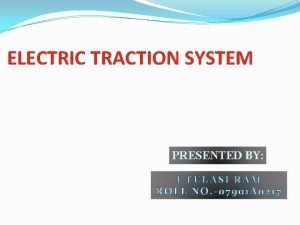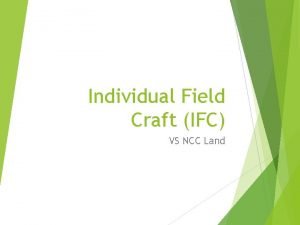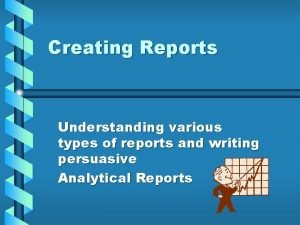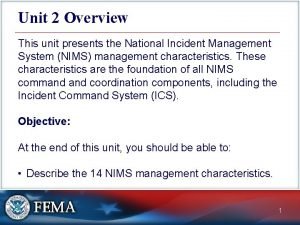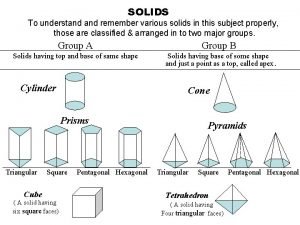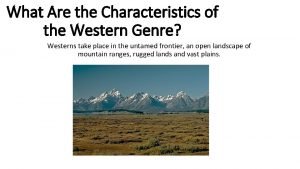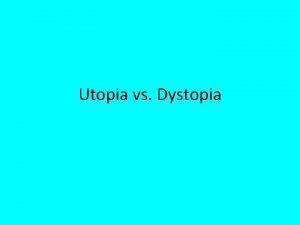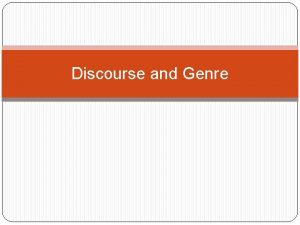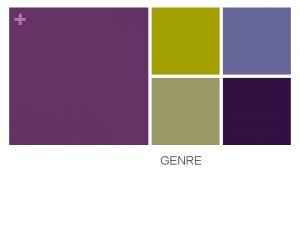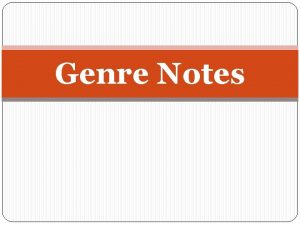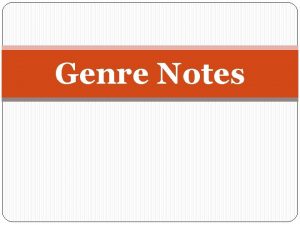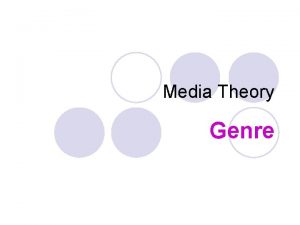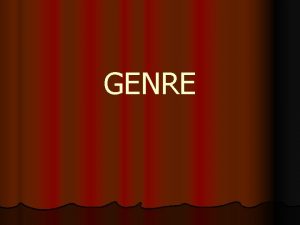GENRE STUDY LEARNING THE CHARACTERISTICS OF VARIOUS TYPES









- Slides: 9

GENRE STUDY!!! LEARNING THE CHARACTERISTICS OF VARIOUS TYPES OF LITERATURE.

PERSONAL NARRATIVE • Written in first person (I, am, we, my, us, me, mine, our) • Dialogue • Story Telling • Setting (includes people, place and time) • Sequence (Chronological order-Time) • Factual

POETRY • Uses Figurative Language ex. Simile, metaphor, hyperbole, personification • Rhyme scheme (possibly) • Stanzas, line breaks • Imagery

EXPOSITORY NONFICTION (RESEARCH) • Form a Research question (something you want to learn more about or seek an answer to) • Identify appropriate sources: encyclopedias, nonfiction texts (biographies, autobiographies other informative materials), websites ending in. org. edu. gov • Gather information from sources • Sort/ sift through the information • Process information to determine meaning • Create a final product that presents your findings including a work cited page

FICTION • Stories from an author’s imagination usually with an emphasis on character development. • Realistic fiction- is a story based on the author’s imagination that could probably happen in real life. • Historical fiction are fictions based in historical events or with historical characters. • Science fiction- fictional stories with scientific information within. • Fantasy-fiction that is usually characterized by use of magical places, characters or items.

LITERARY ANALYSIS • With literary analysis, the focus is not on offering your opinion about the work; rather, the focus is to interpret and analyze the text. • Direct quotes • Indirect quotes • Paraphrasing • Character analysis • Theme analysis • Author analysis • Piece interpretation

ANTHOLOGY • Collection of works that are related • Collections written by the same author • Collection organized by theme • Collection organized by genre • Collection organized by time period

EXPOSITORY NONFICTION (PERSUASIVE) To present an argument or point of view, to influence • begins with a position statement • supported by evidence and examples • attempts to persuade by using logic • and appealing to the reader’s emotions • or sense of moral justice • may include research data • may compare or contrast

RHETORICAL ANALYSIS Analyzing how something is being said (rhetorical analysis). Looking not solely for what the piece is about; we are discovering how it is about what it is about. • Nine possible rhetorical forms in the text: example, definition, comparison-contrast, classification, process analysis, description, narrative, cause-and-effect, assertion/justification. • These are broad forms that the speaker or writer can take to shape the message. Writers decide to hang their message upon one or more of these forms. • The first step toward rhetorical analysis is to identify the forms that the writer has chosen.
 Cuadro comparativo e-learning y b-learning
Cuadro comparativo e-learning y b-learning Arno converter converts
Arno converter converts Types of grounds in ncc
Types of grounds in ncc Sample of cutting tools
Sample of cutting tools Various types of reports
Various types of reports Depending on the incident size and complexity various types
Depending on the incident size and complexity various types A pentagonal pyramid base 25mm side and axis 50mm long
A pentagonal pyramid base 25mm side and axis 50mm long Western movie characteristics
Western movie characteristics Dystopia and utopia meaning
Dystopia and utopia meaning Features of a tragedy
Features of a tragedy

